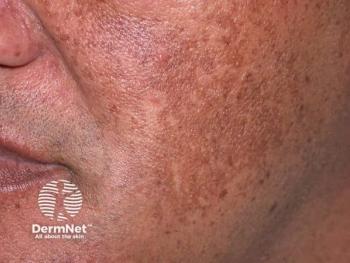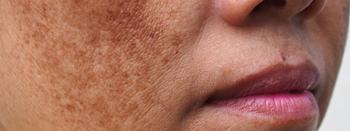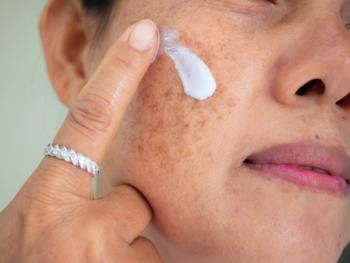
- Dermatology Times, April 2021 (Vol. 42, No. 4)
- Volume 42
- Issue 4
Emerging Agents Augment Melasma Modalities
An array of agents for blocking visible light and lightening skin are joining the armamentarium to treat melasma. Despite this expanding number of therapeutic interventions, melasma is a chronic, therapeutically challenging disease for which there is no cure, so treatment plans should address both management of the disease and patient expectations.
New treatment modalities and novel compounds are expanding the armamentarium for managing melasma and preventing relapse, said Pearl E Grimes, MD, in her update on this challenging skin disease at Maui Derm 2021.1
Grimes, a Dermatology Times®’ editorial advisory board member, is the director of The Grimes Center for Medical and Aesthetic Dermatology, director of the Vitiligo and Pigmentation Institute of Southern California, and clinical professor of dermatology at the David Geffen School of Medicine at UCLA, all in Los Angeles.
Her presentation highlighted new solutions to optimize melasma management and identified cautions that could negatively impact outcomes.
Approaches for Photoprotection
Photoprotection from ultraviolet light has been a long-standing element in the melasma management algorithm. However, findings from recent studies indicating that visible light is also a trigger for the pathogenic pathway have spurred research showing the benefits of photoprotection strategies using iron oxide sunscreens that block visible light, Grimes noted.
“Using these modalities in our practice, we are seeing they have a significant positive impact in patients with melasma,” Grimes said. “Oral Polypodium leucotomos extract has also been investigated as a novel photoprotective agent in melasma. Recent data suggest that [it] also blocks visible light, and it has shown benefit as an adjunctive modality for melasma patients in several randomized studies.”
Current evidence from histological studies suggesting that melasma likely represents a phenotype of photodamage carries implications for long-term management, Grimes noted.
Novel Lightening Agents
In addition to photoprotection, topical lighteners have a cornerstone role in managing melasma. Most lighteners used currently act via tyrosinase inhibition. Hydroquinone has been the major workhorse in this category for 60 years. However, new and emerging agents are showing substantially greater efficacy, according to Grimes.
Newer options for treating hyperpigmentation include cysteamine, methimazole, silymarin, tranexamic acid (TA), glutathione, melatonin, and new combination formulations. Most of these agents also inhibit tyrosinase activity, but some have different or multimodal mechanisms of action and have been used with varying routes of administration, Grimes said.
TA is one example. This antifibrinolytic agent suppresses angiogenesis, mast cells, and arachidonic release. It has been used orally, topically, and intralesionally with good results, she said. However, Grimes pointed out some concerns with TA—including an almost-universal risk for relapse after treatment is stopped and a risk for inducing thromboembolic phenomena.
“Although thromboembolic events are uncommon or rare in studies investigating TA for dermatologic conditions, patients should be screened for thromboembolic risk factors,” she advised.
Therapeutic Procedures
Procedural interventions are strategic partners in the multimodality approach for melasma.
Chemical peels are part of the armamentarium for treating melasma as a second-line regimen, and superficial peels are preferred for treating melasma in darker-skinned patients.
“Findings from a meta-analysis showed that for patients with Fitzpatrick phototypes IV to VI, increasing the depth of the peel also increases the risk of more [adverse] effects or deleterious outcomes,” Grimes said.
Maximizing outcomes with peels requires a combination approach, in which a topical lightener is used for 2 to 4 weeks preceding the peel and between procedures, she said, adding that in her opinion, the daily regimen is key to achieving best-possible results.
Grimes pointed out that multiple recent studies also show that microneedling can have a role in melasma treatment when used in combination with a topical lightening agent. But there are certain caveats.
“In my experience, it is essential to have patients on a daily topical lightening agent when using microneedling. Without it, there is a significant risk for development of postinflammatory hyperpigmentation,” Grimes said.
Light-based treatments using lasers or intense pulsed light (IPL) sources may target deeper pigmentation along with a vascular component of melasma that is much more prominent than previously thought.
“Very tiny telangiectasia can often be seen when closely examining patches of melasma,” said Grimes. “Although these vessels were once considered a result of what patients had used for treatment, they are now known to be part of the melasma spectrum.”
Only fractional 1550/1540 nm nonablative lasers are approved by the FDA for treating melasma. However, treatment with a low-fluence Q-switched Nd:YAG laser may be the best option for refractory cases of melasma, according to Grimes. Excellent results can also be achieved using IPL sources in Fitzpatrick skin types II, III, and sometimes IV, she added.
However, because of the risk for significant complications, IPL should be used with extreme caution in darker-skinned patients. “The Q-switched ruby and erbium:YAG lasers are best avoided completely,” she said.
Managing Expectations
Despite the expanding number of therapeutic interventions, the fact remains that melasma is a chronic and therapeutically challenging disease for which there is no cure. Moreover, relapses are almost universal, said Grimes. Therefore, establishing realistic expectations for outcomes remains a critical aspect of the therapeutic consultation.
“Whereas we can cure postinflammatory hyperpigmentation of the face often caused by acne by treating the inciting condition, it is essential to articulate to patients with melasma that their pigmentary disorder requires long-term management,” Grimes said. “Meanwhile, we continue to have hope that the quest to find new therapies for this psychologically devastating condition will lead to options that are more durably efficacious.”
Disclosure:
Grimes has conducted clinical research and/or served as a consultant for Procter & Gamble, Clinuvel Pharmaceuticals Ltd, L’Oréal, Johnson & Johnson, LaserOptek, VT Technologies, Incyte, Pfizer Inc, and DermaForce.
Reference:
1. Grimes PE. Update 2021: disorders of pigmentation. Presented at: Maui Derm Live In-Person Dermatology CME Conference and Maui Derm Connect Virtual Dermatology CME Conference; January 25-29, 2021; Maui, Hawaii; virtual.
Articles in this issue
over 4 years ago
Regenerative Medicine Gaining Popularityover 4 years ago
Combination Foam May Benefit Patients of Colorover 4 years ago
AI Diagnostics Fall Short in Skin of Colorover 4 years ago
Microneedling Strategiesover 4 years ago
Neuromodulators Combat Key Rosacea Challengesover 4 years ago
Baricitinib Demonstrates Positive Outcomes for Alopecia Areataover 4 years ago
COVID-19 Vaccine Refusal: Grounds for Termination?over 4 years ago
Tazarotene Excels Across BMI Categoriesover 4 years ago
Solving Pierced Earring Challengesover 4 years ago
Laser Device Purchases Are Guided by Multiple FactorsNewsletter
Like what you’re reading? Subscribe to Dermatology Times for weekly updates on therapies, innovations, and real-world practice tips.


















